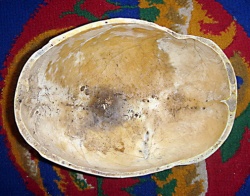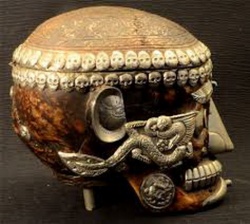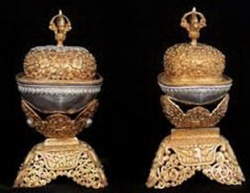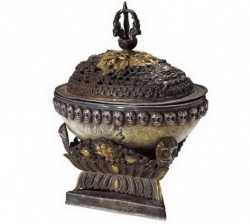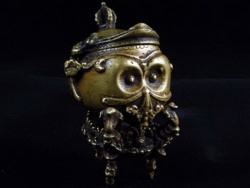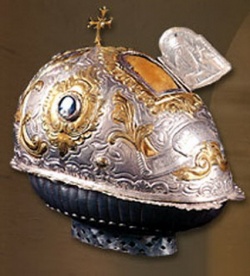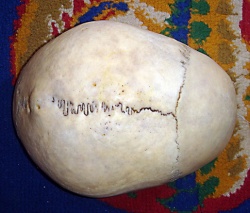The practices and rituals of Tibetan Kapala skull caps
The kapala is a sacred sculpted cup made from the top of a human skull frequently offered by Hindu and Buddhist worshipers to their fierce deities.
A legacy of the ancient tradition of human sacrifice, the kapala is nowadays perceived as a dark but fascinating form of sculpture. Tibetan kapalas, in particular, feature impressive bas-relief artworks depicting religious figures and scenes, and are often adorned with semi-precious stones and silver-work. The elaborate carvings were handmade and the skull was soaked in water to soften the bone.
In Tibet, skull cups are used at Buddhist altars to offer wrathful divinities either wine, which symbolizes blood, or dough cakes shaped as human eyes or ears. Through the force of tantric visualization based on meditation and deep philosophical study, a sort of transubstantiation will occur and the wine will be transformed into the Wisdom Nectar, a liquid form of the enlightened mind of one or all the deities in the Celestial Palace of the Mandala. This is just one of the many uses of the kapala in Tibetan ritual culture.
Some modern-day kapalas are still shaped like the top of a human skull, but they are made of brass and while they are adorned with artistic motifs, they aren’t nearly as fascinating as genuine human skull cups.
The word ‘Kapala’ is a Sanskirt term meaning ‘skull’, 'bowl', 'vessel', 'begging bowl' and is a decorative human skull used as a ritual implement in both Hindu and Buddhist Tantra. They were often carved with decorative designs or elaborately mounted with precious metals and jewels. There are two main types of kapalas – those that use a full skull, and those that only use the skull cap or top-half of the cranium.
The kapalas were usually made from skulls collected at sky burial sites, an ancient Tibetan burial custom, still practiced today, in which the bodies of the dead are dismembered and scattered over open ground to ‘give alms to the birds’. It is a ritual that has a great religious meaning of the ascent of the soul to be reincarnated into another circle of life.
Once collected, the skulls would be specially prepared and elaborately anointed and consecrated before use. It would then be decorated with carvings, jewels of silverwork before being used as a ritual implement.
In Tibetan monasteries, the kapala was used to hold dough cakes or wine, used symbolically as flesh and blood offerings to wrathful deities of Hindu India and Buddhist Tibet. When symbolising blood it is called Asrk Kapala, and when with flesh it is called Mamsa Kapala. The dough cakes were not just pieces of bread, but were shaped to resemble human eyes, ears and tongues.
The skull cup, when used as libation to gods and deities to win their favour, is usually held in the left "wisdom" hand and held in front of a deity's heart where it may be paired with such right hand 'method' implements such as the vajra or curved knife. Many wrathful deities hold a curved knife above a skull cup in front of their hearts symbolizing the union of their method and wisdom. The Hindu goddess Kali, for example, is often depicted holding or drinking from a blood-filled Kapala. The curved knife serves as the "method" weapon that severs the life and vital organs of demonic enemies and the skull cup is the "wisdom" vessel in which the blood and organs are collected as the deity's life source.
Kapalas were also used in rituals like higher tantric meditation to achieve a transcendental state of thought and mind within the shortest possible time, as offering bowls on the altar or as eating or drinking bowls. It was believed that the people who drank out of the skull caps would obtain the knowledge and personality from the person to whom the skull belonged. The use of a human skull as a drinking cup in ritual use or as a trophy is reported in numerous sources throughout history and among various peoples, and among Western cultures is most often associated with the historically nomadic cultures of the Eurasian steppe
The skulls were often regarded as "karmic vessels" which contain the good and bad qualities of the dead person. The karmic force of the dead is believed to be still alive in the skull and thus will infect living beings on touch. Therefore, it is said that only with the proper religious instruction and Tantric transmission one is able to make skilful use of the power of skulls and avoid harm caused by bad karma associated with the skull.
Depending on the purpose, the kapalas would contain such substances as: divine nectar (Skt. amrita), vital nectar (semen), alcohol, ritual cakes or tormas, fresh blood, marrow, intestines, fat, as well as the brains, heart and lungs of demonic enemies.
Although the skulls were once used for spiritual purposes and to achieve higher states of consciousness, like many other traditions there are cases of the rituals being adulterated to suit the purposes of cults and for use in the ‘dark arts’. For example, there are cases of kapalas being produced after the murder or ‘sacrifice’ of a victim followed by the eating of their flesh. The skull of a child who died during the onset of puberty was believed to have great potency as would the "misbegotten skull" of a 7-8 year old child born from an incestuous union. The sectioning of skulls also carried certain meanings. For example, a one-sectioned skull are those of highly realized persons, which a skull with six or more sections represents illness and would be used in ‘destruction mantras’.
Many carved and elaborately mounted kapalas survive today, mostly in Tibet. A skull cup symbolizes cutting through the identification with our body and its endless wants and needs by remembering death – impermanence.
During tantric rituals, one offers one’s hatred and greed and transforms them by ‘cooking’ them in the skull cup which transforms them into nectar with the help of the meditational deities who add their blessings.
This nectar in turn is offered to all sentient beings as all the food, medicine and worldly and spiritual help they need. he skull cup, or kapala (Sanskrit), is a cup made of the oval upper section of a human cranium. Skull cups are used primarily in Tibetan rituals and symbolic art.
Skull Cups in Tibetan Art
In Tibetan sculptures and paintings, skull cups are often seen in the hands of wrathful Buddhist deities, usually held at the level of the heart and often paired with the curved knife or chopper. The weapon slays demonic enemies, and the cup is the oblation vessel in which the blood and organs are collected as the deity's sustenance. Descriptions of the contents of a wrathful deity's kapala include warm human blood, blood and brains, blood and intestines, human flesh and fat, the heart or the heart and lungs of an enemy, the heart of Mara and the blood of Rudra.
Less often, non-wrathful Buddhist deities are depicted with a skull cup, which holds less violent contents. Padmasambhava, for example, holds a skull cup described as an ocean of nectar, in which floats a longevity vase.
Skull Cups in Tibetan Ritual
Ritual skull cups are traditionally formed from a human skull that has been cut into shape, lined with a metal rim and ornamented. Many skull cups are simply made out of a precious metal in the form of a cranium. They are usually elaborately decorated with artistic designs and Buddhist symbols like lotuses and vajras. Many are fitted with ornamented lids and have feet or a separate base in the form of human skulls.
As the libation vessel of a Vajrayana Buddhist, the skull cup can be seen as a parallel of the clay pot (kumbha in Sanskrit) of the Vedic sacrifice, the alms bowl of the Buddha, and the sacred water vase (kalasha in Sanskrit) of the bodhisattvas. In addition, as a receptacle for sacrificial offerings presented to wrathful deities, the skull cup parallels the tray of auspicious substances like jewels, flowers, or fruit presented to peaceful deities. In its most benign symbolism, as the begging bowl or food vessel of an ascetic, the skull cup serves as a constant reminder of death and impermanence.
When used for esoteric rituals, the history of the cranium's original owner has an important bearing on its ritual potency. The skull of a murder or execution victim is believed to possess the greatest tantric power; the skull of one who has died from a violent or accidental death, or from a virulent illness, possesses a medium magical power; the skull of a person who died peacefully in old age has virtually no occult power. Having great potency are the skulls of children who died during the onset of puberty or were born from the forbidden union of castes, out of wedlock, from sexual misdemeanor, or particularly from incest. The vital force or potential of the skull's previous owner is embodied within the bone as a spirit, rendering it as an effective power object for the performance of rituals.
In the ritual, lamas and other advanced practitioners drink consecrated alcoholic beverages or sometimes even blood from the skull cup, symbolizing the wrathful deity drinking the blood of his or her victim.
Representing a human skull cup, the kapala is an aid to our Dharma practice as it remind us of what we are supposed to visualise during our prayers and meditations.
Offering a kapala to one’s Guru is excellent as it will be used during prayers and rituals. Through this act, we create the merits to receive such initiations in the future; and to do these practices to benefit ourselves and others.
Kapala holds the nectar used for performing higher esoteric rituals. It is used during higher tantric meditation in order to achieve a transcendental state of thought and mind within the shortest possible time. It is used to offer liberation to gods and deities to ensure their devotion. In Tibetan Buddhism, the Kapala or Skull Bowl is used ritually in a number of ways. For example, the Lama may use it as an offering bowl on the altar, filled with with wine or blood as a gift to the Yidam Deity or all the Deities in the Mandala. Through the force of the practice of tantric visualizations based in deep philosophical study and meditationa sort of transubstantiation will occur, and the wine or blood will be transformed into the Wisdom Nectar, a liquid form of the Enlightened Mind of the Deity or all of the Deities in the Celestial Palace of the Mandala. That can then be ritually imbibed by the yogi, or the Lama can choose to share it with members of His Heart Family, as in a Vajrayana Empowerment ceremony.
